calsfoundation@cals.org
Yell County
| Region: | Northwest |
| County Seats: | Danville, Dardanelle |
| Established: | December 5, 1840 |
| Parent Counties: | Pope, Scott |
| Population: | 20,263 (2020 Census) |
| Area: | 930.21 square miles (2020 Census) |
| Historical Population as per the U.S. Census: | |||||||||
|
1810 |
1820 |
1830 |
1840 |
1850 |
1860 |
1870 |
1880 |
1890 |
1900 |
|
– |
– |
– |
– |
3,341 |
6,333 |
8,048 |
13,852 |
18,015 |
22,750 |
|
1910 |
1920 |
1930 |
1940 |
1950 |
1960 |
1970 |
1980 |
1990 |
2000 |
|
26,323 |
25,655 |
21,313 |
20,970 |
14,057 |
11,940 |
14,208 |
17,026 |
17,759 |
21,139 |
|
2010 |
2020 |
|
|
|
|
|
|
|
|
|
22,185 |
20,263 |
|
|
|
|
|
|
|
|
| Population Characteristics as per the 2020 U.S. Census: | ||
| White |
15,330 |
75.7% |
| African American |
251 |
1.2% |
| American Indian |
197 |
1.0% |
| Asian |
202 |
1.0% |
| Native Hawaiian or Other Pacific Islander |
13 |
0.1% |
| Some Other Race |
2,542 |
12.5% |
| Two or More Races |
1,728 |
8.5% |
| Hispanic Origin (may be of any race) |
4,204 |
20.7% |
| Population Density |
21.8 people per square mile |
|
| Median Household Income (2019) |
$43,923 |
|
| Per Capita Income (2015–2019) |
$22,015 |
|
| Percent of Population below Poverty Line (2019) |
16.6% |
|
Yell County, Arkansas’s forty-second county, was formed on December 5, 1840, from portions of Scott and Pope counties. Located in west-central Arkansas, the county has a northern portion adjacent to the Arkansas River and is part of the Arkansas River Valley geographic region, while the southern and most of the eastern portions are within the Ouachita National Forest, and a small portion of eastern Yell County is within the Ozark St. Francis National Forest. Named for Governor Archibald Yell, the county boasts a forest products and lumber industry, poultry production and processing, row crops, and livestock production.
European Exploration and Settlement
Hernando de Soto’s expedition encountered strong resistance at Tula in 1541, which archaeologists generally believe to be near the present-day town of Bluffton in southwestern Yell County. Carden Bottom, located in the northeastern corner of the county, is rich with archaeological evidence of the prehistoric people who lived in the area. Various Native American tribes including the Osage, Caddo, and Cherokee, began to migrate to the area beginning in the late 1790s and early 1800s. In 1819, Thomas Nuttall noted Cherokee settlements along the Arkansas River within the boundaries of contemporary Yell County.
Louisiana Purchase through Early Statehood
David Brearley, the third factor at the Spadra Bayou factory, established a home near Dardanelle Rock on the Arkansas River. The factory was a trading post designed to serve Native Americans. Brearley remained in the area and was a founder of the county’s first town, Dardanelle, which was incorporated in 1855. Upon its creation, it had five separate townships and a population of 1,247. A meeting between federal officials, Arkansas Cherokee, and acting governor of the Arkansas Territory Robert Crittenden was held near the present-day location of Dardanelle on June 24, 1823. Known as the Treaty of Council Oaks, the meeting did not ultimately lead to a treaty or a resolution to land disputes between the Native Americans and the white settlers.
Immigrants from Tennessee and North Carolina were prominent in its early development. By 1860, the population reached 6,333, of which 3.9 percent were enslaved. Slavery was concentrated near Dardanelle in the bottom lands adjacent to the Arkansas River. Only three slave owners were certified as planters in 1860. Most slave owners were small farmers. The first cotton gin opened in 1838 in Riley Township near Belleville.
In 1832, a series of religious revivals was held, beginning with a Cumberland Presbyterian movement in the southern part of the county. In 1840, a Baptist church was established in Dardanelle, followed by a Presbyterian church in 1843 and a Methodist church in 1851. Cephas Washburn, who founded Dwight Mission in 1820 and retired at Norristown (Pope County) in 1857, was the first minister of the Dardanelle Presbyterian Church. A Roman Catholic church was established in the 1850s in Carden Bottoms.
In 1840, the first county seat was established at the Monrovia settlement, five miles northwest of Danville. The seat was soon moved to Danville, where the first courthouse was erected in 1844.
Steamboats traversed the Arkansas River beginning in 1820, landing at the Dardanelle Wharf and linking, via the Petit Jean River, Danville to Dardanelle. The 1823 military road between Fort Smith (Sebastian County) and Little Rock (Pulaski County), now Highway 22, was the first road. In 1841, the first mail line began operation, linking by ferry boat Norristown to Dardanelle, Monrovia, and Booneville (Logan County). The first newspaper, the Dardanelle Post, a forerunner of the Dardanelle Post Dispatch, began publishing in 1853. In 1860, telegraph service linked Dardanelle to Fort Smith and Little Rock.
Civil War through Reconstruction
The 1860 federal census reported that 998 enslaved people were held in bondage in the county with 5,335 white citizens. W. H. Spivey, the owner of two enslaved people according to the census, represented the county at the 1861 Secession Convention.
The citizens of Yell County enthusiastically supported the Confederate cause, raising three separate units. Given its Arkansas River location, Dardanelle became a focal point of military action as both Union and Confederate troops attempted to secure control of this strategic river link between Fort Smith and Little Rock. Union troops secured control over the northern part of the county in October 1862. Three Confederate attempts between 1862 and 1865 to retake the area proved unsuccessful. These skirmishes spilled into the bottoms south and east of Dardanelle and resulted in property and crop damage and guerrilla warfare. Both the Baptist and Presbyterian churches at Dardanelle were destroyed. Fighting in the county included the Capture of Dardanelle, Skirmish at Petit Jean, Skirmish at Dardanelle, Skirmish at Beatty’s Mill, Attack on Steamer Alamo, and Skirmish at Bogg’s Mills.
The Medal of Honor was awarded to First Sergeant William Ellis, Company K, Third Wisconsin Cavalry, for gallantry in action at Ivey’s Ford and Dardanelle on January 14, 1865. A review of the original 116-man roster of the Daniel’s Rifles (Company H, First Arkansas Mounted Rifles—one of the Yell County units) reveals that, by 1865, forty-one had been killed, thirty-seven had been wounded, and three were missing.
Post Reconstruction through the Gilded Age
In 1875, Dardanelle was established as a second county seat. This dual system continues into the twenty-first century.
In 1877–1878, more than eighteen Moravian, Slovak, and Bohemian families arrived in the county. Referred to as “the Bohemians,” these Eastern Europeans, primarily farmers and coal miners, were unique in their language, dress, cultural habits, and religion. They initially formed their own social clubs, fraternal organizations, and a community brass band; today, their descendants reside primarily in and around Dardanelle.
In 1883, the five-and-a-half-mile-long Dardanelle and Russellville Railroad (D&R, or “Dinky,” one of the shorter “short lines” still operating in Arkansas) connected Yell County to the Missouri-Pacific line in Pope County. The county’s first bank, the Bank of Dardanelle, opened in 1895. Between 1895 and 1942, seven banks operated in the county.
The D&R was instrumental in the building of the Pontoon Bridge between Yell and Pope counties. Seventy-two wooden pontoon boats floated the river, and upon these, an eighteen-foot-wide roadway approximately 2,300 feet in length was constructed. Pilings driven into the riverbed anchored the pontoons against the river’s current. Foreman Richard Joseph Keilch from Dublin, Ireland, supervised the building and became the superintendent managing the Dardanelle Pontoon Bridge. Completed in 1891 at a cost of $25,000, this was the longest pontoon bridge in the world and operated until 1929, when it was replaced by a two-lane steel bridge.
Mount Nebo State Park, with 1,000 level acres on its summit and numerous freshwater springs at its bench 300 feet below the summit, lies seven miles west of Dardanelle and rises 1,800 feet above sea level. The park stands where, in 1889, the Summit Hotel opened for business. Three stories high, it featured 100 guest rooms, a ballroom and casino, overflow cottages, billiard rooms, kitchens, dining rooms, stables, a post office, and medical services. This luxury hotel was a well-attended tourist stop for the wealthy prior to its 1918 destruction by fire.
Eight white men were lynched in the county in the late nineteenth century for a number of alleged crimes. Jim Holland lost his life in 1881 after being accused of murder. A mob killed Dr. Flood and John Coker in 1883 after they were accused of harboring criminal fugitives. Other lynchings took place in 1888, 1890, and 1897.
Early Twentieth Century
In 1907, the Dardanelle, Ola and Southern Line was completed, which carried freight and passengers and made twelve daily runs; it became the Rock Island Line in 1911. The first telephone service was initiated before the end of the nineteenth century.
Politics has always been serious business and a form of Yell County entertainment. The county’s political mystique was enriched in 1915 during a circuit judgeship special election. The Yell County candidate, A. B. Priddy, carried the county and barely lost in the other two counties involved, and yet he won the election by 2,500 votes. It was reported that names taken from tombstones and birddogs were recorded as voters in Yell County. Thus was born the phrase, “The Free State of Yell,” signifying a tendency of the county to act as an independent nation.
An educational institution supporting the education of boys in Yell and surrounding counties opened in 1921. The Winchester School for Mountain Boys operated until 1932 when the building burned.
As elsewhere, Yell County suffered from the effects of the Depression. The drought of 1930 only added to the economic misery. The American Red Cross in 1930 advised the planting of turnips for feeding families and livestock, and it donated seed for gardens and pastures. Property tax delinquencies rose dramatically from 1930 through 1937 and caused schools to request federal aid, shorten school terms in order to maintain operations, and pay teachers in credit warrants redeemed by local merchants as long-term credit purchases. Banks failed, suicides increased, local businesses reverted to a cash-only basis (except for teachers), and the Dardanelle Post Dispatch decreased its number of pages and slashed subscription rates twice. It also consistently ran editorials advising support for local businesses and promoting the importance of optimism, working together to redeem prosperity, and growing Irish potatoes in home gardens.
New Deal programs produced positive effects. In July 1933, the Civilian Conservation Corps (CCC) began work on cabins, trails, and roads at Mount Nebo. One of the structures constructed by the CCC is the Company 749 Powder Magazine, listed on the National Register of Historic Places.
Also in July 1933, 2,269 county cotton farmers signed contracts to reduce planting. By August 1933, county businesses were pledging participation in the National Recovery Act. By November, 1,800 men had requested work with the Civil Works Administration (CWA). The county’s CWA quota was originally set at 533 jobs, mainly road and bridge work, but this was increased in mid-December 1933 to 733. By January 1934, CWA jobs were limited to a maximum of twenty hours weekly in order to employ more job seekers. In 1933, Yell County was one of the first counties in Arkansas to meet its agricultural allotment reduction and payment quota. During the 1934–35 crop season, the pre-Depression average cotton acreage of 50,000 acres had been decreased to 30,000 acres, which provided $560,000 in payments to Yell County farmers. By 1937, fifty-five percent, or 1,742, of Yell County farmers were tenant farmers.
World War II through Modern Era
During the late 1940s, Yell County was part of the vanguard of Arkansas’s emerging poultry industry. Harold Snyder opened Arkansas Valley Feed Mills in Dardanelle in the fall of 1946. In February 1949, Snyder and the Dardanelle Chamber of Commerce promoted new broiler house development. In 1959, Snyder’s Arkansas Valley Industries purchased the Dardanelle Fox Deluxe Plant, which was then purchased by Tyson Foods in 1984. By 2007, the Dardanelle plant had 269 growers, 1,100 employees, and processed 1.3 million chickens a week. In Danville, Wayne Farms opened in 1970.
Major floods, especially of the Arkansas River, were recorded in 1898, 1904, 1908, 1916, 1927, 1943, 1945, and 1957. Each time, the Arkansas River deposited sand atop the rich bottomland topsoil and temporarily displaced hundreds of families. In 1969, the Dardanelle Lock and Dam was completed, part of the McClellan-Kerr Arkansas River Navigation System, and ended the flooding. Lake Dardanelle, the reservoir created by the dam, offers water sports and fishing.
The Arkansas River Valley Area Council, an effort by the federal government to reduce poverty in Yell and surrounding counties, began operations in the 1960s. The county’s public schools desegregated during the 1960s. The two largest, Dardanelle and Danville respectively, both desegregated without incident during the 1964–65 school year.
During the 1980s and 1990s, Hispanic immigration increased. Attracted primarily by poultry industry employment, the Hispanic population in 2020, concentrated in Danville and Dardanelle, numbered 4,204, or 20.7 percent of the population. The 2020 census shows that white residents account for 75.7 percent of the total population 20,263.
Professional baseball pitcher and coach Johnny Franklin Sain is a Yell County native, as is professional golfer John Daly. Negro League player Alfred “Slick” Surratt was born in Danville. State Republican Party chair William Spicer and U.S. Senator Tom Cotton are also from Yell County. Character actor Arthur Lee Hunnicutt was born in Yell County and was nominated for an Academy Award in 1952. James Lee Witt, former director of the Federal Emergency Management Agency (FEMA) during the administration of Bill Clinton, was from Dardanelle. The county was also featured in Charles Portis’s novel True Grit, with the heroine, Mattie Ross, hailing from “Yell County near Dardanelle.”
The impact of tourism is great. Given the county’s six lakes, three rivers, inclusion as part of two national forests, Mount Nebo State Park, Lake Dardanelle State Park, Tri-Peaks Professional Bicycle Race, and the Holla Bend National Wildlife Refuge, Yell County attracts numerous sports and outdoorsmen. Major tourist activities include hiking, hunting, fishing and water sports, camping, bicycling, and bird watching. Dardanelle has more than a dozen state championship trees. Sites in the county listed on the National Register of Historic Places include the Dardanelle Confederate Monument, the Dardanelle Post Office, the Yell County Courthouse in Dardanelle, and the Sulphur Springs Cemetery.
In addition to the two county seats, communities in Yell County include the incorporated towns of Ola, Belleville, Corinth, Havana, and Plainview. Other communities include Sulphur Springs, Chickalah, and Harkey Valley.
For additional information:
Banks, Wayne. History of Yell County, Arkansas. Van Buren, AR: The Press Argus, 1959.
Gleason, Mildred Diane. Dardanelle and the Bottoms: Environment, Agriculture, and Economy in an Arkansas River Community, 1819–1970. Fayetteville: University of Arkansas Press, 2017.
History of Yell County Vertical Files. Arkansas River Valley Regional Library, Dardanelle, Arkansas.
Nuttall, Thomas. A Journal of Travels into the Arkansas Territory During the Year 1819. Fayetteville: University of Arkansas Press, 1999.
Sadler, Genevieve Grant. Muzzled Oxen: Reaping Cotton and Sowing Hope in 1920s Arkansas. Little Rock: Butler Center Books, 2014.
Yell County Historical and Genealogical Association. Yell County Heritage: A History of Yell County, Arkansas. Bedford, TX: Curtis Media, Inc., 1997.
Mildred Diane Gleason
Arkansas Tech University
Revised 2022, David Sesser, Southeastern Louisiana University
 Fourche La Fave River
Fourche La Fave River Nimrod Dam and Lake
Nimrod Dam and Lake Slater, Rodney Earl
Slater, Rodney Earl Belleville School
Belleville School 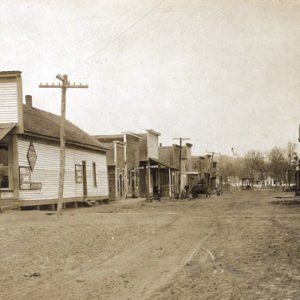 Belleville Street Scene
Belleville Street Scene  Birta Street Scene
Birta Street Scene 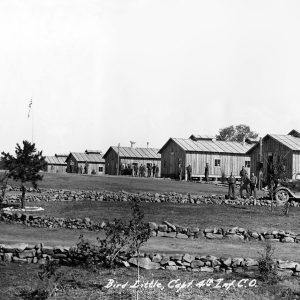 Civilian Conservation Corps Camp
Civilian Conservation Corps Camp 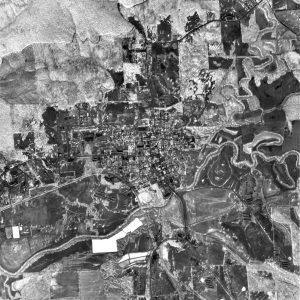 Danville Aerial View
Danville Aerial View 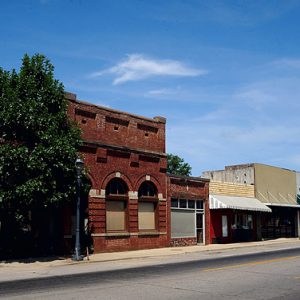 Danville Street Scene
Danville Street Scene  Dardanelle Rock Natural Area
Dardanelle Rock Natural Area 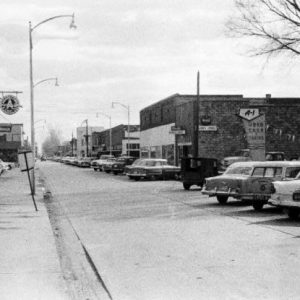 Dardanelle Street Scene
Dardanelle Street Scene  Mount Nebo Hang Gliding
Mount Nebo Hang Gliding 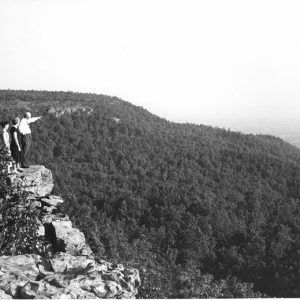 Mount Nebo State Park
Mount Nebo State Park 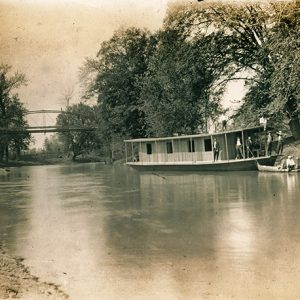 Petit Jean River at Danville
Petit Jean River at Danville  Snow Geese
Snow Geese  Turkey Caller
Turkey Caller  Yell County Courthouse
Yell County Courthouse  Yell County Courthouse
Yell County Courthouse 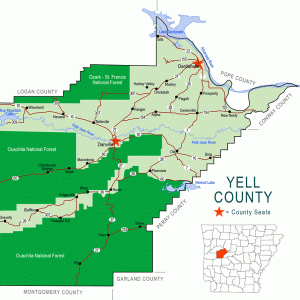 Yell County Map
Yell County Map 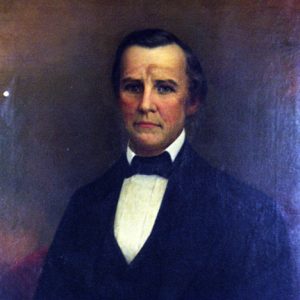 Archibald Yell
Archibald Yell 



I would like to find out about historic churches in what is now known as Slaty Crossing in Yell County. Especially a believed to be a Catholic church.